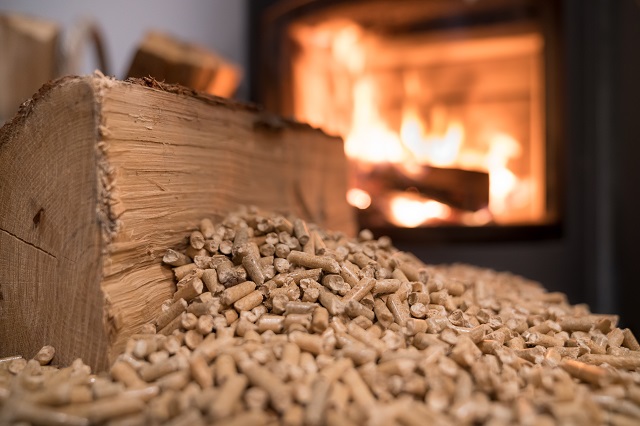
On This Page:
- How Pellet Stoves Work
- Pellet Stove Efficiency
- Pros and Cons
- Pellet Stove Maintenance & Common Issues
How Does a Pellet Stove Work?
A pellet stove burns pellets made from organic materials such as food or wood waste. They are usually in the form of densely packed, small cylindrical pellets. One ton (about 50 bags) is equal to 1½ cords of firewood.
These pellets are stored in the stove’s hopper. A hopper can hold 35 to 130 pounds of pellets. From the hopper, pellets fall into the firebox, the section of the stove where they’re heated up to warm your room. Most stoves have an auto igniter, but you might have to manually ignite if you own a budget model.
Pellet stoves are unique because they use a thermostat. When the thermostat is set, an auger screw turns and releases pellets into the firebox until there’s enough to bring the [stove/room] up to temperature. Lowering the thermostat releases fewer pellets; raising the thermostat releases more.
Inside the stove are two fans. One blows air across the fire to maintain a steady temperature. A second fan blows heat into exchangers. These heat the interior of the stove and then the room. Exhaust gases vent outdoors through a narrow [pipe/duct?].
Pellet Stove Efficiency
Pellet stoves cost between $1,030 and $3,090. That’s not far from the average cost to install a fireplace, $2,170. Although, pellet stoves are much more energy-efficient than fireplaces.
Not all manufacturers will list accurate efficiency ratings (if they list a rating at all). When looking at the listed efficiency rating, it pays to know what a good efficiency rating is.[3]
In general, a good pellet stove will have an energy efficiency rating of 65% to 75%. EPA-certified stoves are 70% to 83% efficient. Look for a hangtag certifying that the EPA tested and approved the stove’s efficiency.
Pellet Stove Pros and Cons
Pros
- They’re easy to use: ignites at the push of a button. No kindling or tending to the fire required.
- Cleaning is a breeze. There’s no creosote buildup and less ash volume compared to wood.
- Bags are easier to transport, handle and stack.
- Pellets take up less storage space than firewood.
- You have greater temperature control. Turn a thermostat dial to get the perfect temperature.
- They’re eco-friendly because there’s very little air pollution. Pellets burn cleaner than wood.
Cons
- It’s expensive to maintain compared to firewood and needs more upkeep than a fireplace.
- The fan makes low, mechanical noise.
- Aren’t as visually appealing as watching a fire in a fireplace.
- It needs a backup system like batteries or electricity to run in case of a power outage.
Pellet Stove Maintenance
Maintaining a pellet stove is an ongoing task, just like more familiar fireplaces. Expect to clean the ash pan weekly or even daily, depending on how often you use it. Neglecting your stove will shorten its 10- to 15-year life expectancy.
- Daily
- Empty the ash pan after use.
- Weekly
- Vacuum the fans and ash pan.
- Brush the vents.
- During
the Cold Season
- Check its ignitor 3x during the cold season. If it fails, a new igniter costs $15-$50, not including labor.
- After
Winter
- Give the stove a thorough cleaning. Be sure to get any ash and leftover pellets out.
Common Issues
A properly installed and maintained pellet stove should last at least 10 years. Some have track records of more than 20 years, but most owners believe that stoves last as long as they can get parts.
Failure usually stems from one of four areas.
- Poor maintenance: the leading cause of stove failure. Follow the manufacturer’s recommended maintenance schedule.
- Poor fuel: clogs up fans and blowers. Use higher grade fuel and clean regularly.
- Poor installation: happens most often when an owner tries to DIY the job. Hire a professional for the best results.
- Manufacturer defects: a risk for just about anything. Most stoves come with 1- to 2-year warranties — read through them to know what’s covered.
Cleaner than a fireplace or wood stove, safer than a gas heater, and warmer than an electric space heater, it’s no wonder that pellet stoves are increasingly popular. This unique stove might be just what you need to supplement your whole-house system.
 Turn Your Fireplace into a Work of Art with a Fireplace Surround
Turn Your Fireplace into a Work of Art with a Fireplace Surround  Preventive Maintenance: Chimneys
Preventive Maintenance: Chimneys  Chimney Bombs
Chimney Bombs  Stoking the Fire: Fireplace Remodels
Stoking the Fire: Fireplace Remodels  Upgrading Your Fireplace
Upgrading Your Fireplace 

Are You Familiar With This Topic? Share Your Experience.